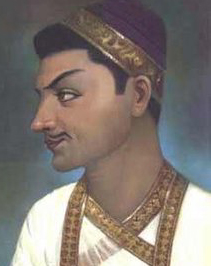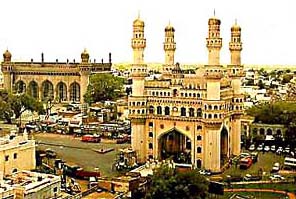Hyderabad History
The city is more than 400 years old and is noted for its many mosques, temples, minarets, bazaars, and beautiful geography. It lies on the Deccan (Dakkan) plateau, 541 meters (1776 feet) above sea level, and sprawls over an area of 260 km²(100 mile²). A multitude of influences have shaped the character of the city. Its palaces and buildings, houses and tenements, gardens and streets have a history and an architectural individuality of their own. This land of 75 million people has an inimitable heritage dating back to times immemorial.
The Rulers of Hyderabad
 The area around Hyderabad was once part of Ashoka's Empire in the 3rd century BC. Various Hindu kingdoms like the Kakatiyas ruled the area for many centuries, and the region was claimed by both Hindu and Muslim leaders until the late 14th century, when Muhammad Quli Qutb Shah consolidated power and established the fortress city of Golconda nearby.
The area around Hyderabad was once part of Ashoka's Empire in the 3rd century BC. Various Hindu kingdoms like the Kakatiyas ruled the area for many centuries, and the region was claimed by both Hindu and Muslim leaders until the late 14th century, when Muhammad Quli Qutb Shah consolidated power and established the fortress city of Golconda nearby.
Hyderabad was founded by Muhammad Quli Qutb Shah on the Musi River five miles east of Golconda in 1591-92. Quli Qutb Shah also ordered the construction of the Char Minar, one of the most famous monuments in the city, in 1591. The Qutb Shahi dynasty founded and ruled the Kingdom of Golconda, one of the five kingdoms that emerged after the break up of the Bahmani Sultanate. All seven Qutb Shahi sultans were patrons of learning and were great builders. They contributed to the growth and development of Indo-Persian and Indo-Islamic literature and culture in Hyderabad. During the Qutb Shahi reign Golconda became one of the leading markets in the world for diamonds, pearls, steel, arms, and also printed fabric. In the 16th century, the city grew spontaneously to accommodate the surplus population of Golconda, which was the capital of the Qutb Shahi rulers.
The Rulers of Charminar
 In 1687, the Golconda sultanate was conquered by the Mughal emperor Aurangzeb, and Hyderabad became part of the Mughal Empire. As the empire weakened in the 18th century, provincial officials gained greater autonomy. In 1724, Asif Jah, who had already been granted the title Nizam al Mulk by the Mughal emperor, defeated a rival official to take control of Hyderabad province, and established his independence from the Mughals. His successors ruled as Nizams of Hyderabad. The rule of the seven Nizams saw the growth of Hyderabad both culturally and economically. Huge reservoirs, like the Nizam Sagar, Tungabadra, Osman Sagar, Himayat Sagar, and others were built. Survey work on Nagarjuna Sagar had also begun during this time.
In 1687, the Golconda sultanate was conquered by the Mughal emperor Aurangzeb, and Hyderabad became part of the Mughal Empire. As the empire weakened in the 18th century, provincial officials gained greater autonomy. In 1724, Asif Jah, who had already been granted the title Nizam al Mulk by the Mughal emperor, defeated a rival official to take control of Hyderabad province, and established his independence from the Mughals. His successors ruled as Nizams of Hyderabad. The rule of the seven Nizams saw the growth of Hyderabad both culturally and economically. Huge reservoirs, like the Nizam Sagar, Tungabadra, Osman Sagar, Himayat Sagar, and others were built. Survey work on Nagarjuna Sagar had also begun during this time.
When the British and the French spread their hold over the country, the Nizam won their friendship without bequeathing his power. The title "Faithful Ally of the British Government" was bestowed on Nizam VII. The British stationed a Resident at Hyderabad, but the state continued to be ruled by the Nizam. Hyderabad, under the Nizams, was the largest princely state in India, with an area larger than England and Scotland put together. The State had its own currency, mint, railways, and postal system. There was no income tax.
Soon after India gained independence, it forcefully annexed Hyderabad through Operation Polo, and became an Indian state. On November 1, 1956, the map of India was redrawn into linguistic states, and Hyderabad state was divided between Andhra Pradesh, Bombay state (present-day Maharashtra), and Mysore state (present-day Karnataka). Hyderabad and the surrounding area were added to Andhra Pradesh based on Telugu linguistic majority, and Hyderabad became the capital of the state.